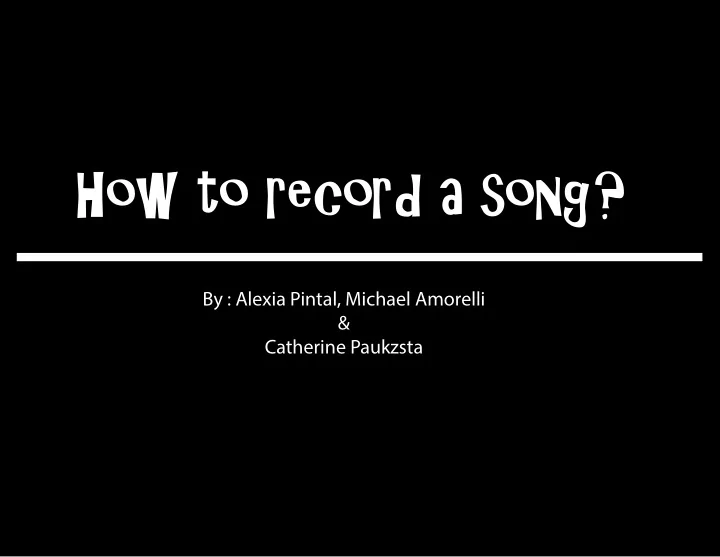

How to record a song? By : Alexia Pintal, Michael Amorelli & Catherine Paukzsta
Step 1: Pre Recording -Equipement: In order to record a song, you’re going to need a micro phone. A pop filter to reduce harsh sounds. If you dont have a pop filter, you can put a sock over your microphone. You’re gonna need a microphone stand. A computer & Headphones . And you are going to need a D.A.W which stands for Digital Audio Workstation. (This is where all your vocals are going to be processed and later edited). We use FL Studio 12 but every D.A.W works the same way so it comes down to personal preference. If you are not looking to invest in a D.A.W , we suggest Audacity which is free to use.
Step 1: Pre Recording -Set up: Take the microphone. Put it on the microphone stand Plug it into the computer Turn on your D.A.W And youre ready for Step 2
Step 2: Recording - Vocals tips and tricks For this tutorial we are recording our version of the song Want You Back by 5 Seconds of Summer Feel free to record any song you like including your own Once your instrumental is loaded up in your D.A.W, you must decide how you want to record. There are two ways to record, sitting down or standing up. Try out both and see which one you like most before clicking the record button and sing away. Face the micophone front words. If you have trouble hearing yourslef remov e one headphone offof your ear. Dont forget to adjust the imput volume of your microphone depending on how loud your vocalist is and their distance from the microphone
Step 2: Recording - General Rule of Recording When recording vocals, you must stand about 6 inches away from your microphone Tip 1: The general rule is to stand about 6 inches away from your microphone. Tip 2: Face your microphone at all times when recording. ` Tip 3: If you are having trouble hearing yourself during the recording, take one ear off of your headphone. Tip 4: Place the pop filter between your artist and the microphone but do not stick it on your microphone. Tip 5: Adjust the input volume of your microphone depending how loud your vocalist is and their distance from the microphone. Take note of this 5 tips that will improve the quality of your vocal takes.
Step 3: Processing and Mastering Open up your D.A.W Once you are done with your vocal takes and you feel as if you have done enough, select your individual v ocals and find which ones sound the best. Feel free to crop each vocal at the specific part you like. Once you find your best vocal takes, its time to add vocal effects.
Step 3: Processing and Mastering Vocal effect: Autotune: You’re gonna wanna choose your inptu type (which is your voiceif you’re low pitch and high pitch) Retune speed: The fatser that is the more robotic you sound Humanize: The higher that is the more human-like you sound Change your scale according to the scale of the song so that your auto -tune fits in smoothly and you dont sound like T-Pain
Step 3: Processing and Mastering EQ: (equalizer) This is where you listen nto your recording and check the frequencies of your sound If you drastically boost or drastically lower its not going to sound good but little nudges higher to boost the frequencies of the sounds you like makes it sounf good and it is to take out the frequencies you dont like mess around with it until y ou find something that sounds good to you. Compression: Compressed your voice so all the super loud sounds get lower and all the low sounds get higher to this middle ground. This can be ajusted with your threshold and your ratio. The threshold you want is about the middle of your vocals. Your Ratios about 2/1. If you take away too much volume , you could always reboost it with the game. If it’s too loud, you could always lower the game.
Step 3: Processing and Mastering Reverb: This makes your vocals sound more ambient like you are in a big room or a small room according to you. The wetness level makes it sound much wider like you are in a church. The dryness basically makes your vocals dry and less ambient. Find a good middle ground to give your vocal takes some life. Delay: Its the echo on your voice. Helps end your vocal nic ely and flow into the next.
Step 3: Processing and Mastering Volume: Once you are done adding your v ocal effects, its time to adjust your volume. Vocal Layering: Stack your voals on top of eachother . It creates this cool effect. A trick that you can use is to take the first vocal take and push it alll the way to one ear and push the other vocal take to the other ear and the last one in the middle. It creates this really nice ambience around your headphone. This comes with alot of practice and time so play around with it and be patient. You will soon create a killer song.
Recommend
More recommend